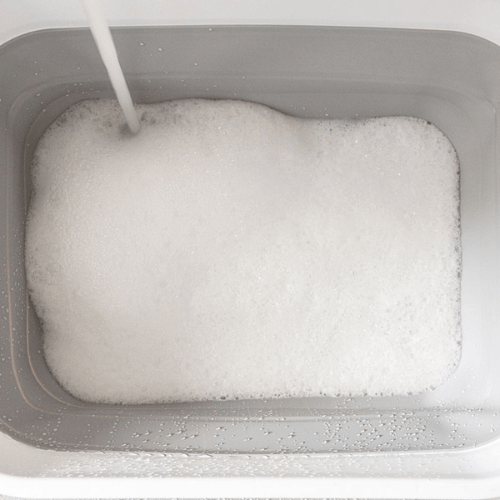How do you wash and dry a cotton pillow? You can keep your cotton pillow clean and fluffy with these simple steps.
Many people don’t know how to properly clean their pillows.
Pillows should be washed at least once every few months depending on usage, in order to ensure they stay clean and free of dust mites or other allergens. Cotton pillows are particularly easy to take care of, as long as you know what steps to take when washing them.
First, fill your washer with lukewarm water and add some mild detergent or color-safe bleach if desired.
Then place the pillow inside the machine and set the cycle for gentle agitation before letting it finish its cycle.
Once done, remove the pillow from the washer immediately so that it doesn’t become overly saturated with water – this can cause it to become lumpy or misshapen over time.
Discover in-depth instructions on how to clean and dry a cotton pillow.
1. Gather Supplies

Washing a cotton pillow is like performing a delicate operation.
Gathering the necessary supplies is the first step in ensuring success. Start by gathering a mild detergent, a washing machine, and one or two towels.
Make sure the detergent is free of bleach and other harsh chemicals that may damage the fabric.
Once you have these items in hand, you are ready to begin.
Load the washer with your pillow, setting it on a gentle cycle of cold water. Use only enough detergent to lightly cover the entire surface area of your pillow.
If possible, choose a detergent formulated specifically for delicates to keep your pillows feeling soft and smelling fresh.
If using regular laundry detergent, use half of the recommended amount to avoid over-sudsing and damaging your pillow’s fibers.
Once the washing cycle has completed, remove your pillow from the machine immediately and transfer it to the dryer.
Set the dryer on low heat or air fluff setting.
Add one or two clean white towels to help absorb moisture as it evaporates from your pillow during drying.
Remove your pillow once it has dried completely and fluff it up for an extra fluffy finish!
2. Pre-Treat Stains
Before washing the pillow, pre-treat any stains. This ensures that the stain is removed before it sets in during the washing cycle.
To do this:
- Soak: Create a mix of warm water and a mild detergent. Soak the stained area for 15 minutes and then rinse with clean water.
- Spot-clean: Use a soft cloth to dab the stained area with a mixture of water and laundry detergent until it’s gone.
- Rub: For more stubborn stains, use gentle circular motions to rub them away using a mixture of laundry detergent and warm water.
After pre-treating, launder the pillow according to its care instructions. Don’t overstuff the washer as this can prevent thorough cleaning.
When finished, dry on low heat with multiple dryer balls or clean tennis balls tucked inside to help fluff up the cotton fibers.
With these steps complete, your pillow will be looking good as new!
3. Fill Washing Machine With Water
Pouring and preparing the washer is paramount for proper pillow-washing.
Positioning the pillows in the washing machine, pouring in the perfect amount of water and picking the proper settings are necessary for the next step – add detergent.
First and foremost, fill the washer with water.
For best results, pour a sufficient amount into the appliance to cover all of the fabric. Be sure to always use cold water to avoid any shrinkage or fading of colors.
The temperature should be set to either warm or cold, depending on what type of material your pillow is made from.
Once you have added enough water, you can then put your pillows into the machine and secure them properly so they won’t move around during the cycle.
After that, you can choose your wash cycle setting and start it up.
This will ensure that all of your pillows get clean while also protecting them against damage from too much agitation or heat exposure.
4. Add Detergent

Cleansing can be a cinch. Careful contemplation and clever cleansing can combine to create clean cotton. Now, it’s time to add detergent.
To make sure your pillow is pristine, here are three steps for adding the perfect amount of soap:
- Measure out the detergent according to the pillow’s size and fabric type
- Pour the detergent into the water before adding the pillow
- Use only a mild detergent that is specifically designed for washing delicate fabrics
Once you’ve added the right amount of detergent, you’re ready to move on.
5. Select Appropriate Washing Cycle
Complying with the instructions of washing and drying a cotton pillow can be likened to a journey; one that requires careful steps.
As we reach the sixth step, let us remember that it is essential to select an appropriate washing cycle. This is key in ensuring the best result for our cotton pillows.
Here are 4 important items to consider when selecting a cycle:
- Consider the type of stain on your pillow; certain stains require specific cycles.
- Look at the size of your pillow; if it’s too big it won’t fit into certain washers or cycles.
- Check the temperature settings to ensure they are suitable for cotton fabric.
- Select a gentle cycle such as “delicate” or “hand wash” if your pillow is made from pure cotton or has intricate details like lace or embroidery.
In order to maintain our pillows in their best condition, it is vital that we choose a washing cycle carefully and thoughtfully.
A final check should be done before proceeding with this step to make sure everything has been taken into account, ultimately allowing us to move onto rinsing our pillows with confidence and peace of mind.
6. Extract Excess Water
Once pillow is done rinsing, it’s time to extract the excess water.
To do this, you can spin it in a washing machine on a low speed setting.
If you don’t have access to a machine, wringing out the pillow by hand will also do the trick.
Be sure to hold the pillow with both hands while rotating so that it doesn’t twist or get damaged.
Another tip is to press and squeeze the pillow in all directions instead of twisting it around one spot.
This will help avoid creases or bumps in the fabric which would be difficult to remove later on.
Once you’ve removed as much water as possible, it’s time to move onto drying your cotton pillow.
Make sure you give it enough time for thorough drying—this step is crucial!
7. Dry Pillow

A sigh of relief! You’re almost done with the task of washing and drying your cotton pillow. Now, it’s time to dry your pillow.
But don’t rush the process just yet.
Drying the pillow is an important step in the process that cannot be overlooked; if you do, you may end up with a lumpy, misshapen pillowcase.
So take a deep breath and let’s get started.
To begin, use a gentle cycle in the dryer and set it to low heat. Then add some dry towels to help absorb moisture from the pillow during the drying cycle.
This will ensure that your cotton pillow comes out nice and fluffy after it is finished drying.
Once the cycle is complete, remove it immediately and lay flat on a towel or rack to air-dry until completely dry.
It’s almost done! All that’s left now is to store your freshly washed and dried cotton pillow properly.
8. Store Pillow Properly
It’s the final step: storing your cotton pillow correctly. After all that washing and drying, it’s time to ensure you’re keeping it in top condition.
Unlike other fabrics, cotton needs a little extra care when it comes to storage.
It must be kept away from direct sunlight and moisture, so don’t leave it in an open-air cupboard or on the floor where dampness can seep through.
Instead, store your cotton pillow in a dry place with good air circulation.
You could even invest in a vacuum-sealed bag to keep the pillow dust-free and safe from harm.
Taking these steps will help your cotton pillow stay clean and fresh for longer – no more lumpy or misshaped pillows!
So, make sure you treat your pillow with the respect it deserves and you’ll enjoy its comforting hug for many years to come.
Clean You Pillow Without A Washing Machine
Cleansing a cotton pillow is like taking a sip of cool water on a hot day. You need to be patient and follow the steps correctly for desired results.
Let’s examine the process.
Firstly, fill up the sink with cold water and add some detergent. Place the pillow in the tub, making sure that it is submerged in water completely. Then, scrub the pillow for one to three minutes to ensure thorough rinsing of the fabric:
- Change out the water if necessary
- Allow for proper agitation of all parts of pillow
- Check for soap suds or residue
Once done, you must extract excess water from your pillow before drying it.
Quickly transfer it to another washer or put it in a spin dryer so that it can be dried more quickly without losing its shape.
This will help your pillow remain fluffy and breathable. To achieve best results, make sure all moisture is removed before putting it into a dryer or air-drying outside.
Frequently Asked Questions
How Often Should I Wash My Cotton Pillow?
To keep your cotton pillow clean, soft and hygienic, it’s important to know how often to wash it.
Washing a cotton pillow regularly can be beneficial for your health, as well as the longevity of the pillow. Here are a few tips on how often you should wash it:
1. Once every two weeks: Wash your pillow every two weeks to keep dust mites and other allergens away.
2. When you notice discoloration or an odor: If your pillow has become discolored or smells unpleasant, it may be time for a wash.
3. After sickness: If someone in the household is sick with an infectious illness such as the cold or flu, it’s important to wash their pillows more frequently.
4. After spills or stains occur: It’s important to clean any spills or stains as soon as they happen.
5. Every 3-6 months: Even if no one has been sick, washing your pillow every 3-6 months will help maintain its freshness and softness.
When you’re ready to wash your cotton pillow, use warm water and a mild detergent. Do not use hot water or bleach, as this could damage the fabric and make it less effective at absorbing moisture.
After washing, make sure to dry the pillow completely before using it again. You can either air dry the pillow in sunlight or tumble dry on low heat with a few tennis balls for extra fluffiness.
Washing and drying your cotton pillows regularly is essential for maintaining hygiene and comfort levels while sleeping.
Following these steps will ensure that your cotton pillows stay clean and fresh for longer periods of time!
Is It Safe To Use Bleach When Washing A Cotton Pillow?
It’s like a game of Russian roulette – using bleach on a cotton pillow can be risky business. The potential for success is high, but if you’re not careful, it could end up in disaster.
When it comes to using bleach on a cotton pillow, the safest option is to avoid it altogether. Bleach can damage the fibers and weaken them over time.
If you do decide to use bleach, use only a small amount and mix it with cold water before washing. Make sure to rinse the pillow thoroughly afterward.
A more natural approach would be to use baking soda or vinegar instead of bleach. Both are excellent cleaning agents and won’t damage your pillow. They also help remove stubborn stains that regular detergent may not be able to tackle alone.
TIP: When drying your cotton pillow, hang it outside in direct sunlight whenever possible as this will help keep the fibers strong and prevent fading.
Can I Use A Dryer Sheet When Drying A Cotton Pillow?
Washing a cotton pillow can be a daunting task. But, with diligence and the right tools, it doesn’t have to be a chore.
One important question people often ask is whether or not they can use a dryer sheet when drying their pillow.
The answer is yes, you can use a dryer sheet when drying your cotton pillow; however, there are several things to keep in mind:
1. Start by reading the care tag on your pillow – some materials may need special handling
2. When using a dryer sheet, select one that is free of any harsh chemicals
3. Place the dryer sheet in the dryer along with your pillow
4. Set the dryer temperature to low heat and check periodically to make sure everything is drying properly
5. Remove the pillow from the dryer while it’s still slightly damp
Using this method will help ensure that your cotton pillow remains soft and fluffy for years to come. A few extra steps can save you time and hassle down the road.
So remember: follow the care instructions on your pillow, select an appropriate dryer sheet, keep an eye on your items as they’re drying, and remove them from the machine before they become too stiff or crunchy.
Is It Safe To Machine Wash A Cotton Pillow?
It’s safe to machine wash a cotton pillow, but there are a few steps you should take first. Before washing, check the care label. It’ll tell you whether it’s machine washable and what temperature of water to use. If it says ‘dry clean only’, don’t put it in your washing machine – that could damage the fabric.
Next, use a gentle detergent and cold water on a delicate cycle. Don’t add any bleach or fabric softener, as this could damage the pillow too. To make sure all the detergent is washed away, do an extra rinse cycle afterwards.
Once the washing is done, tumble dry the pillow on low heat and remove it immediately when finished. Don’t over-dry it, as that can damage the material too. And make sure to fluff it up regularly while drying so it keeps its shape.
That’s how to safely machine wash a cotton pillow – just follow these instructions and your pillow should come out looking good as new!
Can I Use A Spot Cleaner For Any Small Stains On My Cotton Pillow?
When it comes to cleaning pillows, many of us are unsure of how to proceed. A cotton pillow is a great choice for comfort and durability, but can be tricky to wash.
So, can a spot cleaner be used for any small stains on a cotton pillow? Yes!
Spot cleaning your cotton pillow is an excellent way to tackle any small stains that may have occurred.
It is important to remember that spot cleaning should always be done carefully and delicately in order to maintain the shape and quality of the fabric.
To begin, you will need a mild detergent, warm water and a clean cloth or sponge. Start by gently dabbing the soapy mixture onto the stained area until it is completely covered.
Afterwards, use the cloth or sponge to gently wipe away any excess soap and dirt. After allowing it time to dry, your pillow should now be free from stains!
This method of spot cleaning can not only save you time when dealing with small stains on your cotton pillow but also keep it looking good as new for years to come.
Plus, with its simplicity and effectiveness, this technique is sure to become part of your regular cleaning regimen. So go ahead and give it a try – you won’t regret it!





